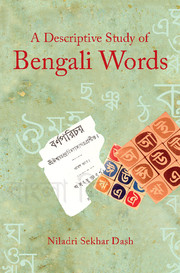Book contents
- Frontmatter
- Dedication
- Contents
- List of Tables
- Bengali Vowel Sounds in Cardinal Diagram
- Preface
- Acknowledgements
- Chapter I Word: A Conceptual Complexity
- Chapter II Usage of Some Word-formative Elements in Bengali
- Chapter III Frequency of Use of Words in Bengali
- Chapter IV Structural Components of Bengali Words
- Chapter V Use of Affixes with Bengali Words
- Chapter VI Postpositions Used in Bengali
- Chapter VII Compound Nouns and Adjectives
- Chapter VIII Structure of Reduplicated Forms in Bengali
- Chapter IX Lexical Naturalization in Bengali
- Appendix I
- Appendix II
- Appendix III
- Appendix IV
- Appendix V
- Appendix VI
- Appendix VII
- Bibliography
- Author Index
- Subject Index
Chapter VIII - Structure of Reduplicated Forms in Bengali
Published online by Cambridge University Press: 18 December 2014
- Frontmatter
- Dedication
- Contents
- List of Tables
- Bengali Vowel Sounds in Cardinal Diagram
- Preface
- Acknowledgements
- Chapter I Word: A Conceptual Complexity
- Chapter II Usage of Some Word-formative Elements in Bengali
- Chapter III Frequency of Use of Words in Bengali
- Chapter IV Structural Components of Bengali Words
- Chapter V Use of Affixes with Bengali Words
- Chapter VI Postpositions Used in Bengali
- Chapter VII Compound Nouns and Adjectives
- Chapter VIII Structure of Reduplicated Forms in Bengali
- Chapter IX Lexical Naturalization in Bengali
- Appendix I
- Appendix II
- Appendix III
- Appendix IV
- Appendix V
- Appendix VI
- Appendix VII
- Bibliography
- Author Index
- Subject Index
Summary
Introduction
Reduplication is one of the highly productive word formation processes in Bengali. It is quite frequently used in the language for various linguistic reasons and purposes. Also, it is used in different ways and manners to serve various means of information-sharing and communication. Although it is mostly used to express a sense of multiplicity of various countable items, it is also used as a process to refer to the act of continuation of an action or an event.
The process of reduplication is indeed very rich and robust in Bengali. Due to this fact, each and every word used in the language is virtually capable of being reduplicated. However, due to several orthographic inconsistencies, reduplicated words are often written with or without a space between two members. It is observed that the lexical item, which is reduplicated, can either be a word, a morpheme, a syllable, a sequence of syllables, or a string of characters, which does not form a prosodic constituent such as morpheme, syllable, or root, etc. It is also observed that reduplication can occur to all word-classes including the pronouns and indeclinable. In most cases, the process signifies plurality of an item or continuity of an action. Moreover, all kinds of echo and onomatopoeic words, which are quite prevalent in the language, also fall within the list of reduplication.
In this chapter I have tried to analyse the Bengali reduplicated forms with reference to their structure to explore how various parts of words tend to concatenate to generate the final forms and what kind of morphophonemic alternation takes place in the whole process of generation of reduplicated form.
This study may help readers to identify the processes these words undergo without considering their semantic properties.
- Type
- Chapter
- Information
- A Descriptive Study of Bengali Words , pp. 225 - 251Publisher: Cambridge University PressPrint publication year: 2015
- 4
- Cited by

